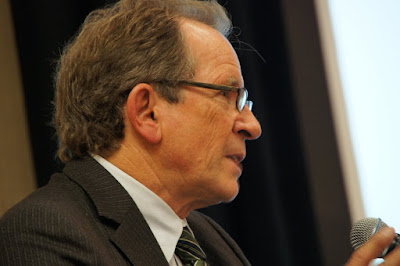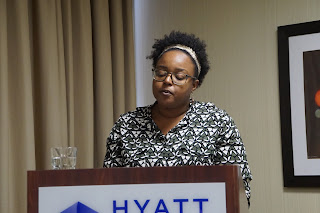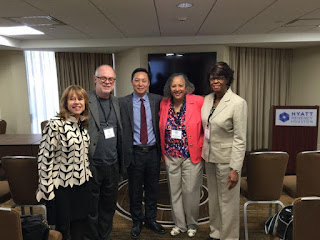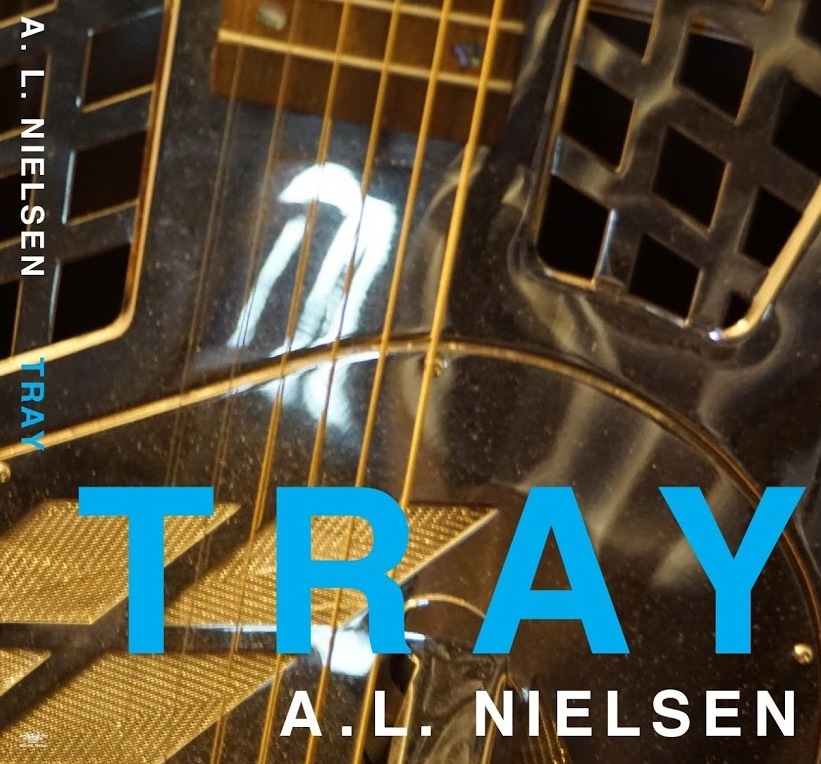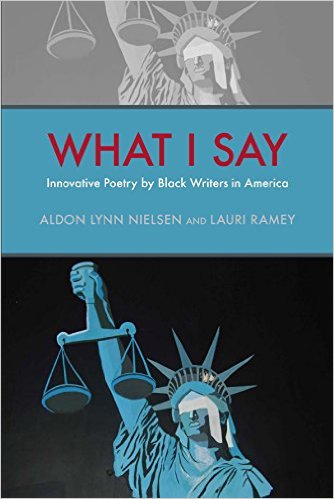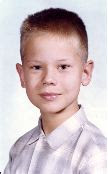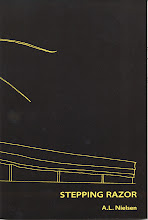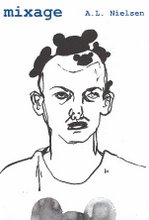Thursday, April 28, 2016
E. Ethelbert Miller - The Aldon Nielsen Project # 18 - MAPPING THE OUTER LIMITS
Q: In WHAT I SAY one finds the poets presented in alphabetical order. I felt your book didn't explain what the various writers had in common. Why didn't you arrange the book around issues of theme and structure? I'm a substitute high school or college teacher and the class is studying the poetry of Julie Ezelle Patton. Where do I begin? If she defines herself as a conceptual artist what boundaries is she crossing when it comes to poetry?
In the end, the decision to arrange the contents of both What I Say and Every Goodbye Ain’t Gone alphabetically by poets’ last names was a choice rooted in a desire to leave readers free to pursue their own mappings through the era (roughly 1948 to now) that the two anthologies carved out. We could easily have gone many other routes, and even toyed with the idea of a random positioning. (At least I toyed with that idea; not sure today that I ever shared the thought with my co-editor, Lauri Ramey.)
Some quick background: for many years, readers of my book Black Chant had been encouraging me to publish an anthology of the poetry that I had discussed in that volume, a volume dedicated to exploring a territory within African American poetry that had gotten somewhat sidelined in the decades after the Black Arts Movement. One of the many striking things about the Black Power and revolutionary years of, say, 1965-1975, was that so many writers, and especially poets, had been at the forefront of the movements, But even in the years leading up to the Black Arts period, many of the African American poetry anthologies had been truly eclectic in scope, attempting to represent the broad aesthetic range of Black verse in America. You can find prose poems in anthologies as early as the 1920s, for instance. At the high water mark of 60s/70s anthologizing, this phenomenon was if anything yet more pronounced. It was in anthologies that I first read the works of such poets as Russell Atkins, Tom Weatherly, Elouise Loftin, Jay Wright, June Jordan and so on and on. With the waning of the Revolutionary 60s/70s, there was an observable decrease in the mainstream publishing of Black poetry anthologies, though many smaller presses kept up the pace. As the 80s came along, the strengthening multicultural reform movements in universities again spurred commercial publishers’ interest in supplying a growing market for classroom texts and the general market. But a funny thing happened; many of the new anthologies struck me as being considerably narrower in their aesthetic choices than had books I’d read in my youth such as Baraka and Neal’s Black Fire. Among the many things I set out to do in writing Black Chant was to historicize the intellectual fashions that had led to the marginalization of poetry in general and more aesthetically radical poetry in particular. Many among my small audience of readers wanted to have a collection they could use in their own work and teaching that was more nearly representative of African American poetry that was as radical in the writing itself as it was in its thematics. (Think Baraka! Think Lorenzo Thomas.) So there was no surprise in the urgings I was hearing towards an editorial project.
But there were material concerns. Chief among them was the fact that for so many of those years I was teaching a 4/4 load and had no access to research funds or research assistants. (There was also the fact I’d already observed that it was probably wiser to wait till I was tenured to take on a time-consuming editing task that, for all its obvious value to readers and to scholarship, would count for little in a tenure case.)
These were among the factors I was outlining to Lauri Ramey the day she first phoned me from Hampton University to chat, and suggested the need for such an anthology. Her immediate response was, “I’ll help you.”
So that’s how we got to the project in the first place, a story I have been telling at panels and readings in support of our second volume, What I Say. We have been as clear as we could be throughout the project that we are aware that others could easily chart a different course through the same history. Some times this was not by our own choice. (It still pains me that there is nothing from Jay Wright or Julia Fields in our first collection, but they each, for different reasons, didn’t care to be anthologized further at the moment. Similarly, I keep thinking that if I had delayed finalizing What I Say just a few months longer [it had already been years, mostly due to my commuting life mode] we could have included Tonya Foster, LaTasha Diggs and others.) Many will look at the word “innovative” in our subtitles and immediately think of poets they would have added under that rubric. If anything, my response is to hope that they will. We need more such books. One place to look for an alternate reading of things is the dossier of radical poets prepared for the journal boundary 2 by Dawn Lundy Martin just last year.
In the end, the alphabetical organization was our way of encouraging readers to come to their own conclusions about lineages and affiliations. This doesn’t always turn out as I would have it. In our short preface to What I Say we mention the fact that a few of the poets in that book had friendships with various of the L=A=N=G=U=A=G=E poets. I’ve observed in the few months since the book appeared that some people introducing our work at conferences and readings have a tendency to highlight that fact, somewhat obscuring our book’s evidence of the many routes that different poets took to the experimental modes visible and audible in their works. In the many decades since Grove Press published Donald Allen’s The New American Poetry anthology, many critics have argued with the implementation of his geographical groupings of the poets therein. One Amazon reviewer of Ron Silliman’s collection In the American Tree reacted to that book’s organization, writing “I think in my copy I crossed out the words West and East in the book and wrote above them ‘Us’ and ‘Them.’” On the other hand, chronological arrangements (most often organizing by the poets’ dates of birth) struck me as entirely too likely in this case to present a false picture of a ceratin “progress.” Thematic arrangements can often be productive, but generally this is true when the anthology itself is built around a particular set of subject matters, rather than, as in our case, built around the desire to assert an important continuing history of experiment. I don’t know that I have seen many anthologies built around particular structures, unless we’re thinking of things like sonnet collections, or haiku anthologies. Part of the point of our books is to underscore the continuous generation of new forms. And yes, as editors we could have produced a much longer explanatory introduction, but I have an aversion to repeating arguments that I have made in print already, an aversion that comes from having had so many editors over the years encourage me to say again what I have already said, when what I want to say is something else. (Those who have not yet seen What I Say can look forward to its wonderful introductory essay on the subject of anthologizing by poet C.S. Giscombe.) And I know it’s something of an evasion to advise people who want to know what all these poets have in common to go read Black Chant and Integral Music, and the many essays I’ve published since . . .
But here’s the nutshell, already burst, the contents escaping in all directions.
The poets presented in these two anthologies have in common their participation in the ongoing aesthetic rupture that shows up in poetry with Modernism. Now, experience teaches me that some will read that and rush to the same sort of mistake as those who overemphasize the role of White experimentalists (or even White mentalists) in these developments.
Here’s the thing, as we say nowadays, relatable, in fact. I follow C.L.R. James and W.E.B. DuBois in making the argument that the peoples of the African diaspora were not just subjects of Modernism, not simply inspiration for so many of Modernism’s breakthroughs, but were demonstrably producers of Modernism, even, as DuBois and James teach us, the very condition of possibility for the emergence of Modernity as a historical fact.
So, yes, we can read Amiri Baraka telling us of his early readings in Joyce, Eliot, Beckett, cummings, Yeats etc. But what sort of readers would we be if we overlooked the equal importance in his evolution of Langston Hughes, of James Weldon Johnson (author, in my view, of the first Modernist novel by an African American author), and of all those preachers he heard in his parents’ church? We’d be, sad to say, the kind of readers who have written so many essays overlooking just that lineage.
What the poets in our anthologies have in common, then, is Williams (William Carlos), Hughes, Olson, Johnson, Moore, Césaire, Lorca, Senghor, and let’s not forget the poetics of Armstrong, Ellington, Williams (Mary Lou), Monk, Coltrane, Ayler . . .
These poets are not the only ones who have read, listened to and been influenced by this lineage, but for these poets these predecessor artists are not just subject matter and inspiration. Williams revised the adage about art being nature’s mirror by urging us to see what the poet does as not copying nature, but doing what nature does, bringing new things into being. Césaire represented his people, but his poetry was no simple act of representation.
Terms like “MFA” poetry are clearly an unsatisfactory shorthand. We could substitute terms like “mainstream poetry,” “AWP poetry,” “official verse culture.” Back at the time of Allen’s New American Poetry it was common to divide the poets into the academic and its anti-, but those were terms describing styles of writing, not the professional locus of the poets themselves, or even their level of scholarly learning. Any of these terms must be written under erasure. For example, both mainstream MFA programs around the country and the AWP itself are clearly more welcoming of the more radical poetries now than they were in earlier years. (For so much of the 80s and 90s, the AWP newsletter seemed to be on a campaign against poststructuralism AND cultural Studies AND surrealism and its rapidly proliferating offspring.) At this past AWP conference in Los Angeles, there was a panel celebrating Rae Armantrout, Harryette Mullen gave a reading, and there was even a What I Say panel. A few poet/editors have tried to float terms such as “hybrid verse” or “post-avant” to signal this greater mainstream receptiveness – But all you have to do is look at the way postmodern visual art is now enshrined in major museums and then look to the rewards structure of the American poetry community (the MacArthurs are a good place to see this) to recognize that when it comes to America’s poetry culture, there is very much still a mainstream, with its describable and preferred poetics.
And I think this is demonstrated, too, by the fact that so many years had passed since we’d last seen anthologies that did the work of these two books. Ken Burns did the neat trick in his Jazz series of pairing onscreen diminutions of the achievements of Ornette Coleman with a CD series that sold Ornette Coleman. Similarly, while nobody, I trust, would think of publishing something that announced itself as an encompassing anthology of contemporary African American verse without including the work of Baraka, they mostly don’t include Russell Atkins or Julie Patton.
As to teaching Patton, our anthology is a good starting point, as you might not run into her work too many other places. But even our book has its drawbacks. Patton’s long poetic tribute to Baraka should have been in color. We simply had no money for publishing color plates. What we did publish affords an opportunity for students to confront not only the oral tradition in Black verse, but also the unpronounceable in Black verse. Beyond giving students a reason to think carefully about the relationships between the soundings of poetry and the visual forms in which it appears, Patton also calls for us to rethink our understandings of performance. Mention “performance poetry” in most contexts and everybody will think of slams and open mic nights. But how often does a Julie Patton appear at an open mic among all the emoters taking their cues from people who took their cues from Def Poetry Jam? What has happened is that too many take nothing more than the attitude and delivery mode from what they’ve seen of the Black Arts, and don’t go to school with the revolution in verse that accompanied the political revolution. There will soon be an example of Julie Patton in performance online, drawn from the publication reading for What I Say that took place at Cal State LA’s new downtown campus during AWP. The audience never knows what Patton is going to do when she approaches a microphone, not even audiences that have been to her gallery shows or have seen her with a band. On the night of the reading in LA, she began by making a few opening comments; next thing we knew she was singing a complex (unheard of?) improvisation that made music from the names of other poets in the book, addressed individuals sitting in the audience, even incorporated a bit of the epic piece by her that’s in the anthology. Performances like that demand that we attend to this as an art form that belongs in the ranks with our greatest page poets. Given the long history we have with being able to speak intelligently about Sonia Sanchez’s improvisations, Jayne Cortez’s superrealism, Ntozake Shange’s choreo-poems, Sun Ra’s chants, can it really be that difficult to comprehend a multimedia poet of the stature of Patton? At the same time, should not Patton’s work cause some disturbance in the field of poetic conceptualism as it is currently constituted? In the last year there has been a raging controversy surrounding racism and the works of Kenneth Goldsmith and Vanessa Place, leading lights in what is presently termed conceptual poetry, and yet that terming has a bad case of presentism. The debates have gone on as though no Black artists had ever been involved in conceptualism – No Adrienne Piper, let alone Mendi and Keith Obadike, and certainly no Julie Patton. Patton’s work not only interrupts standard conversations around the boundaries of verse, it reconceives the conceptual itself.,
But the bottom line for What I Say is, as it was for Every Goodbye Ain’t Gone, found in the work itself. It is often said that “experimental poetry” teaches you to read it as you read. These two anthologies are open to myriad openings of pathways through the territories, and each pathway reveals another turning in the question of what these poets have in common, and what we have in common with them, a certain way, as Giscombe has it, of complicating the yakety yak.
Tuesday, April 26, 2016
BLEED THROUGH - Michael Davidson's New & Selcted Poems
I had occasion just recently, responding to an essay by Steph Burt, to write of the centrality of Whitehead's process philosophy to mid-century New American Poetry, which of course entails its importance to all that has come after. Olson, in his "A Later Note on Letter #15," had written:
"& Descartes was the value
until Whitehead, who cleared out the gunk
by getting the universe in (as against man alone
& that concept of history"
It was Process and Reality that had made the turning. "We diverge from Descartes by holding that what he has described as primary attributes of physical bodies, are really the forms of internal relationships between actual occasions." This was from lectures Whitehead had given in 1927-28, but it was to become part of the very vocabulary of the poetics coming to be known as the postmodern. You can find passages in Olson, Baraka and Creeley taking up this very phrasing.
That was the first of Michael Davidson's works to catch my attention. That cover collage by Jess included letters barely discernible, almost a bleed through, informing the very close reader that the book included "the foul papers" -- what was there not to love -- One odd thing about that Sand Dollar Press book, released in 1976: the collage was printed on a sleeve, which when removed revealed an identical collage in a different color, on which the title of "The Foul Papers" was more legible. So it was a sort of bleed through after all, and that effect is eerily present again, four decades on, on the cover of Davidson's New and Selected.
After a first meeting, at which I said something so stupid I always prayed Davidson didn't recognize that we had met before when we met again, we became friends, and I have been able to document several of his great readings and lectures for postings on Penn Sound. (Go take a look!)
Somehow the new book came out without my noticing -- Back in the day when I lived in large metropolises, and those metropolises had book stores, I would routinely find things like The Mutabilities and Bleed Through in my wanderings through the shelved cities. But I've found it now, and it is a find. From Coffee House Press.
And now, on Pennsylvania primary day, as I cast my vote against Cruz control, I take comfort in "The Canadians":
I want
to occupy what
has not been bought, the space
where the earth meets the earth.
"& Descartes was the value
until Whitehead, who cleared out the gunk
by getting the universe in (as against man alone
& that concept of history"
It was Process and Reality that had made the turning. "We diverge from Descartes by holding that what he has described as primary attributes of physical bodies, are really the forms of internal relationships between actual occasions." This was from lectures Whitehead had given in 1927-28, but it was to become part of the very vocabulary of the poetics coming to be known as the postmodern. You can find passages in Olson, Baraka and Creeley taking up this very phrasing.
and there was a later post, visible on the last page of Michael Davidson's The Mutabilities:
AFTER WHITEHEAD
The sequence is up in the air,
I'm outside or inside
in each case
it's the truth
but who tells it
is up to the code . . .
After a first meeting, at which I said something so stupid I always prayed Davidson didn't recognize that we had met before when we met again, we became friends, and I have been able to document several of his great readings and lectures for postings on Penn Sound. (Go take a look!)
Somehow the new book came out without my noticing -- Back in the day when I lived in large metropolises, and those metropolises had book stores, I would routinely find things like The Mutabilities and Bleed Through in my wanderings through the shelved cities. But I've found it now, and it is a find. From Coffee House Press.
And now, on Pennsylvania primary day, as I cast my vote against Cruz control, I take comfort in "The Canadians":
I want
to occupy what
has not been bought, the space
where the earth meets the earth.
Saturday, April 23, 2016
KEITH WALDROP -- SELECTED POEMS
"Almost everybody, you
know, is dead."
These many years later I still recall the force of those words against my eyes as I stood in a used book store staring at a page of Keith Waldrop's so wonderfully titled book The Garden of Effort.
That was my origin story, and those carefully placed commas simultaneously alluded to the sound of the lines as spoken, and kept them from meaning what they might if unpunctuated.
Decades later I found myself lingering over a line in Claudia Rankine's Don't Let Me Be Lonely: "Is everyone you know alive?"
It was that reading in The Garden that sent me East of Eden to find the rest of Waldrop. What I came to first was his first, A Windmill Near Calvary.
By then I knew, too, of Rosmarie Waldrop, and it was at a reading of hers that I met Keith. Rosmarie was part of an Emily Dickinson program at the Folger Shakespeare Library. I lived within walking distance of the Folger in those days, and made sure to be there. Keith, it turned out, was taking a train from Providence to meet Rosmarie, and was himself ambling over from Union Station, and we were introduced at the reception.
I would have gone on reading both poets whether I'd met them or not, but I have enjoyed their hospitality in Rhode Island ("Rogue Island" was what the Puritans in Massachusetts called it) and was able to return the favor at least once.
know, is dead."
These many years later I still recall the force of those words against my eyes as I stood in a used book store staring at a page of Keith Waldrop's so wonderfully titled book The Garden of Effort.
That was my origin story, and those carefully placed commas simultaneously alluded to the sound of the lines as spoken, and kept them from meaning what they might if unpunctuated.
Decades later I found myself lingering over a line in Claudia Rankine's Don't Let Me Be Lonely: "Is everyone you know alive?"
It was that reading in The Garden that sent me East of Eden to find the rest of Waldrop. What I came to first was his first, A Windmill Near Calvary.
By then I knew, too, of Rosmarie Waldrop, and it was at a reading of hers that I met Keith. Rosmarie was part of an Emily Dickinson program at the Folger Shakespeare Library. I lived within walking distance of the Folger in those days, and made sure to be there. Keith, it turned out, was taking a train from Providence to meet Rosmarie, and was himself ambling over from Union Station, and we were introduced at the reception.
I would have gone on reading both poets whether I'd met them or not, but I have enjoyed their hospitality in Rhode Island ("Rogue Island" was what the Puritans in Massachusetts called it) and was able to return the favor at least once.
In 1990, Lost Roads published Keith's The Opposite of Letting the Mind Wander: Selected Poems and a Few Songs, and I've taught that book in classes a few times.
This is the real
morning, and
not the other. There
is no special value in
your fear. To "avoid
unlucky words" is to
"keep a religious
silence."
That was selected from A Ceremony Somewhere Else. As the titles hint, Waldrop's concerns have stayed the course even as his poems have tightened and tautened. No slackness with age --
And now we have this new, beautiful and generous Selected, running from that first Windmill and Windfall Losses (lots of wind power in here) through 2013's Also a Fountain:
"A relativity of the taut string."
Monday, April 18, 2016
WHAT I SAY in D.C. - Anderson, Deas and McMorris
A gorgeous D.C. Sunday afternoon, cherry blossoms on the trees and poetry in Adams Morgan --
The good folk at D.C. Arts Center on 18th Street, Meg Ronan and Tony Mancus, with an assist from Rod Smith, hosted three of the contributors to the What I Say anthology: T.J. Anderson III, Pia Deas and Mark McMorris. Watch for a recording of this amazing reading.
Friday, April 15, 2016
Hanes Symposium 2016 - Black Genius
Genius finds both extremes,
The bottom and the top;
And 'twixt the two he never seems
To find a place to stop.
But high or low his lot,
Genius is genius still,
And whether man heed at first or not,
He must at last and will.
--Albery Allson Whitman 1890
I'm just back from Winston Salem State University in North Carolina, where I spoke in the 2016 Hanes Symposium organized by Dean Corey Walker around the topic of Black Genius. From the outset, we were considering the term in its broadest senses, keeping in mind the meaning as a spirit attendant upon a place, and as an inclination or penchant. A large part of our discussions had to do with questions of how to produce and preserve environments conducive to creativity and achievement. Just walking across campus with Dr. Walker underscored what we had been considering. Seeing him greeting and encouraging students we met along the way reminded me of what a university administrator and scholar should be about.
The morning kicked off with a presentation by Claudrena Harold, from UVa, followed by Howard University's Greg Carr and a wide ranging conversation with Dean Walker.
Following a break for lunch, Steven Thrasher, of The Guardian and NYU, and I gave talks. That's how Albery Whitman found his way into the mix. Dean Walker then rejoined us at the front for more discussion, all of which was being live streamed.
The Hanes Lecture was the capstone event of the day, with dear friend Farah Jasmine Griffin speaking. I first got to know Griffin during my long ago Loyola Marymount days when she was at Penn. The lecture was held in the campus art museum, where a powerful show of works by graduating students was on the walls.
Then it was off to a rollicking dinner with our gracious hosts where the food was fine and the dinner disputation even better than the dessert.
Monday, April 11, 2016
CLA 2016 - Houston
What better way to celebrate the Heat Strings 10th blogoversary than with a return to the College Language Association? CLA gathered in Houston this year, the weather was fine and the papers were jumping.
Good to see so many friends of long standing and to make new ones. The panel I was on brought me together with fellow poet giovanni singleton and my anthology co-editor Lauri Ramey to discuss the legacies of innovation in African American verse from 1948 to now.
additional photos by Lauri Ramey, Lianggong Luo and Donna Akiba Sullivan Harper.
Subscribe to:
Posts (Atom)






